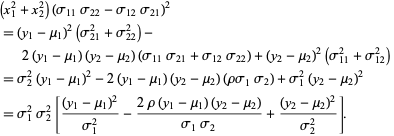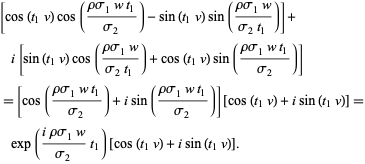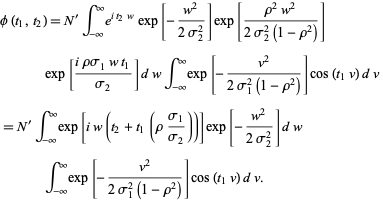


 تاريخ الرياضيات
تاريخ الرياضيات
 الرياضيات في الحضارات المختلفة
الرياضيات في الحضارات المختلفة 
 الرياضيات المتقطعة
الرياضيات المتقطعة
 الجبر
الجبر
 الهندسة
الهندسة 
 المعادلات التفاضلية و التكاملية
المعادلات التفاضلية و التكاملية 
 التحليل
التحليل
 علماء الرياضيات
علماء الرياضيات |
Read More
Date: 17-6-2019
Date: 21-9-2018
Date: 24-3-2019
|
The bivariate normal distribution is the statistical distribution with probability density function
 |
(1) |
where
 |
(2) |
and
 |
(3) |
is the correlation of  and
and  (Kenney and Keeping 1951, pp. 92 and 202-205; Whittaker and Robinson 1967, p. 329) and
(Kenney and Keeping 1951, pp. 92 and 202-205; Whittaker and Robinson 1967, p. 329) and  is the covariance.
is the covariance.
The probability density function of the bivariate normal distribution is implemented as MultinormalDistribution[ mu1, mu2
mu1, mu2 ,
, 
 sigma11, sigma12
sigma11, sigma12 ,
,  sigma12, sigma22
sigma12, sigma22
 ] in the Wolfram Language package MultivariateStatistics` .
] in the Wolfram Language package MultivariateStatistics` .
The marginal probabilities are then
 |
 |
 |
(4) |
 |
 |
 |
(5) |
and
 |
 |
 |
(6) |
 |
 |
 |
(7) |
(Kenney and Keeping 1951, p. 202).
Let  and
and  be two independent normal variates with means
be two independent normal variates with means  and
and  for
for  , 2. Then the variables
, 2. Then the variables  and
and  defined below are normal bivariates with unit variance and correlation coefficient
defined below are normal bivariates with unit variance and correlation coefficient  :
:
 |
 |
 |
(8) |
 |
 |
 |
(9) |
To derive the bivariate normal probability function, let  and
and  be normally and independently distributed variates with mean 0 and variance 1, then define
be normally and independently distributed variates with mean 0 and variance 1, then define
 |
 |
 |
(10) |
 |
 |
 |
(11) |
(Kenney and Keeping 1951, p. 92). The variates  and
and  are then themselves normally distributed with means
are then themselves normally distributed with means  and
and  , variances
, variances
 |
 |
 |
(12) |
 |
 |
 |
(13) |
and covariance
 |
(14) |
The covariance matrix is defined by
 |
(15) |
where
 |
(16) |
Now, the joint probability density function for  and
and  is
is
 |
(17) |
but from (◇) and (◇), we have
 |
(18) |
As long as
 |
(19) |
this can be inverted to give
![[x_1; x_2]](http://mathworld.wolfram.com/images/equations/BivariateNormalDistribution/Inline58.gif) |
 |
 |
(20) |
 |
 |
 |
(21) |
Therefore,
 |
(22) |
and expanding the numerator of (22) gives
 |
(23) |
so
 |
(24) |
Now, the denominator of (◇) is
 |
(25) |
so
 |
 |
 |
(26) |
 |
 |
 |
(27) |
 |
 |
 |
(28) |
can be written simply as
 |
(29) |
and
 |
(30) |
Solving for  and
and  and defining
and defining
 |
(31) |
gives
 |
 |
 |
(32) |
 |
 |
 |
(33) |
But the Jacobian is
 |
 |
 |
(34) |
 |
 |
 |
(35) |
 |
 |
 |
(36) |
so
 |
(37) |
and
 |
(38) |
where
 |
(39) |
Q.E.D.
The characteristic function of the bivariate normal distribution is given by
 |
 |
 |
(40) |
 |
 |
 |
(41) |
where
 |
(42) |
and
 |
(43) |
Now let
 |
 |
 |
(44) |
 |
 |
 |
(45) |
Then
 |
(46) |
where
 |
 |
![-1/(2(1-rho^2))1/(sigma_1^2)[u^2-(2rhosigma_1w)/(sigma_2)u]](http://mathworld.wolfram.com/images/equations/BivariateNormalDistribution/Inline104.gif) |
(47) |
 |
 |
 |
(48) |
Complete the square in the inner integral
 |
(49) |
Rearranging to bring the exponential depending on  outside the inner integral, letting
outside the inner integral, letting
 |
(50) |
and writing
 |
(51) |
gives
 |
(52) |
Expanding the term in braces gives
 |
(53) |
But  is odd, so the integral over the sine term vanishes, and we are left with
is odd, so the integral over the sine term vanishes, and we are left with
 |
(54) |
Now evaluate the Gaussian integral
 |
 |
 |
(55) |
 |
 |
 |
(56) |
to obtain the explicit form of the characteristic function,
 |
(57) |
In the singular case that
 |
(58) |
(Kenney and Keeping 1951, p. 94), it follows that
 |
(59) |
 |
 |
 |
(60) |
 |
 |
 |
(61) |
 |
 |
 |
(62) |
 |
 |
 |
(63) |
so
 |
 |
 |
(64) |
 |
 |
 |
(65) |
where
 |
 |
 |
(66) |
 |
 |
 |
(67) |
The standardized bivariate normal distribution takes  and
and  . The quadrant probability in this special case is then given analytically by
. The quadrant probability in this special case is then given analytically by
 |
 |
 |
(68) |
 |
 |
 |
(69) |
 |
 |
 |
(70) |
(Rose and Smith 1996; Stuart and Ord 1998; Rose and Smith 2002, p. 231). Similarly,
 |
 |
 |
(71) |
 |
 |
 |
(72) |
 |
 |
 |
(73) |
REFERENCES:
Abramowitz, M. and Stegun, I. A. (Eds.). Handbook of Mathematical Functions with Formulas, Graphs, and Mathematical Tables, 9th printing. New York: Dover, pp. 936-937, 1972.
Holst, E. "The Bivariate Normal Distribution." http://www.ami.dk/research/bivariate/.
Kenney, J. F. and Keeping, E. S. Mathematics of Statistics, Pt. 2, 2nd ed. Princeton, NJ: Van Nostrand, 1951.
Kotz, S.; Balakrishnan, N.; and Johnson, N. L. "Bivariate and Trivariate Normal Distributions." Ch. 46 in Continuous Multivariate Distributions, Vol. 1: Models and Applications, 2nd ed. New York: Wiley, pp. 251-348, 2000.
Rose, C. and Smith, M. D. "The Multivariate Normal Distribution." Mathematica J. 6, 32-37, 1996.
Rose, C. and Smith, M. D. "The Bivariate Normal." §6.4 A in Mathematical Statistics with Mathematica. New York: Springer-Verlag, pp. 216-226, 2002.
Spiegel, M. R. Theory and Problems of Probability and Statistics. New York: McGraw-Hill, p. 118, 1992.
Stuart, A.; and Ord, J. K. Kendall's Advanced Theory of Statistics, Vol. 1: Distribution Theory, 6th ed. New York: Oxford University Press, 1998.
Whittaker, E. T. and Robinson, G. "Determination of the Constants in a Normal Frequency Distribution with Two Variables" and "The Frequencies of the Variables Taken Singly." §161-162 in The Calculus of Observations: A Treatise on Numerical Mathematics, 4th ed. New York: Dover, pp. 324-328, 1967.



|
|
|
|
التوتر والسرطان.. علماء يحذرون من "صلة خطيرة"
|
|
|
|
|
|
|
مرآة السيارة: مدى دقة عكسها للصورة الصحيحة
|
|
|
|
|
|
|
نحو شراكة وطنية متكاملة.. الأمين العام للعتبة الحسينية يبحث مع وكيل وزارة الخارجية آفاق التعاون المؤسسي
|
|
|